As the sun was setting, we pulled in to the anchorage at Basseterre. It was a commercial and unprotected bay, yet the regulations in St. Kitts left us no choice but to anchor here for the night and check in to Customs the next morning. Other cruisers had warned of skipping this stop where, if caught anchored in the more desirable locations to the South without checking in first, the fine are astronomical.
The entrance to Port Zante Marina was right in front of us, but daylight was quickly fading. We had tried hailing the marina on the radio from 4:45 pm all the way up until our arrival at 6pm with no reply. (We later found out the marina staff had decided to leave work at 3pm that day. How convenient.) Without being able to see the approach and availability of slips, we decided to not enter the narrow channel and instead anchor just outside in 20′ of water. Only one other boat was in the harbor; a 226 passenger ferry named Caribe Surf, anchored maybe 200′ away. We dropped the hook, made sure our anchor was set, and went to sleep after a rough passage from Statia.
Monday Morning 6.30.14, 6:15 AM
Peter had been awake all night worried about our anchor holding. He had finally fallen asleep around 5am. I awoke a little after 6:00 to the sound of Windy (our wind generator) cranking faster than we’ve ever heard before. With a quick peek outside, it was apparent that we were smack in the middle of a squall. Winds were gusting at 45+ knots and we were surrounded by a wall of white.
I woke Peter up immediately and within seconds he flew up the companionway ladder into the cockpit. Still in bed I called out, “is everything okay?”
“NO!” he shouted back.
“Are we dragging??”
“NO!”
I was a nervous wreck as I climbed outside as fast as I could. Rain started pouring in from every direction. I looked around. We had left the mizzen sail up overnight for stability so we were a bit concerned that the sail might blow out in the squall, but I quickly saw we had bigger problems.
Big is an understatement. The 90′ ferry was coming right for us, backwards.
It just didn’t make sense. Why was it getting closer and closer? Just then we realized, “there’s nobody on that boat and it’s dragging!” The crew had left it anchored overnight with no one on watch. Surely no one was expecting a squall to blow through.
The big blue power-cat was swinging like a pendulum in the wind as it grew closer and closer to our bow. Back and forth it swung on an arch, with each gust getting dangerously closer to us.
We knew we needed to get the sail down, but didn’t have enough time. From where I was standing it looked as if the ferry had already bumped us, though I hadn’t felt the massive aluminum hull bump us yet.
Our Delta style anchor was holding perfectly but Caribe Surf was about to either hit us like a freight train, or catch our chain and drag us to shore. Luckily it was a catamaran and swung just above our rode, avoiding a nasty tangle.
Peter was on the bow trying to hold on to the lifelines as we bounced up and down from the waves. He let go of the snubber after wrapping the main rode around the cleat. His original plan was to let out 50% more rode but just as the last of the rode burned his hands as it slid through his fingers, the ferry was within four feet of our bow. It wasn’t helping.
My whole body was shaking at this point. Both fear and the chill of the piercing rain and wicked wind set me into an unstoppable tremble. Within a matter of seconds I turned the engine on and I yelled out, “Cut the anchor loose!!!!! HURRY!!
It seemed like the wrong thing to do at the time, but Peter knew we had no choice but to let the anchor go.
I scrambled to get the chartplotter, radar and instruments turned on. As soon as he confirmed we were free from the anchor, I hit reverse as hard as it would go. Everything was happening in slow motion. Rain had soaked our entire cockpit but that was the least of our concerns. Suddenly, we started pulling away from the ferry and just as it swung left, I gunned it forward right at 2,000 rpms. At that moment, I was more grateful than I had ever been for our 34 year old 80-horsepower tractor engine.
Still trembling, I motored out to sea away from that horrid ferry.
Peter quickly ran from the bow to the stern to drop the sail after we were out of immediate danger. The squall was still blowing 30+ with zero visibility. He singlehandedly dropped the sail as fast as he could, tying it to the boom in a big heap. Next, he pulled the brake on the wind generator, locking it down. We both looked back to see that the ferry had already run aground on the rocky shore. Whew! That was a close one.
We’re so grateful it happened in daylight. Even though the wall of rain reduced our visibility dramatically, we were still able to see the cruise ship pilings which matched up perfectly with the charts.
Entering a new anchorage, it’s always difficult to know which way gusts will come from and which way a boat might drag. As was the case in St. Kitts, this ferry was on top of us within seconds even though we thought we had picked a good spot to anchor.
After we were motoring out to sea I dug out the lifejackets. We were headed into larger seas and there was no telling when the storm would blow over. Eventually the winds subsided to a manageable 15 knots.
While we were motoring back and forth across the harbor, we saw a small orange tender arrive at Caribe Surf an hour later where they were grounded near shore. We motored closer to them as they prepared to reset a second anchor and we yelled off the bow for the Captain to turn the radio on.
Peter tried a few channels before finding one without traffic and spoke to the Captain.
“Good Morning, this is Caribe Surf. How can I help you today Sir?” He had such a cheery voice, despite the unfortunate chain of events that had just taken place.
Peter wearily explained how their boat had just drug into us during the squall and that we had lost our anchor, leaving no way to secure our vessel. He calmly and kindly told us to pull up to his stern and toss them a line while we wait for his diver. “He can retrieve your anchor.” It was like de-ja-vu pulling up to their stern in the wind. Peter was on the bow while I was at the helm. The damn thing nearly hit us, and here we were getting back into the very position we tried so hard to get away from! A little PTSD ya think?
It turns out that Caribe Surf busted a fluke on their anchor during the squall, causing them to drag with half an anchor still buried. The crew laughed, “That was a nasty squall, wasn’t it?”
After what seemed like an eternity in the early morning hours, the diver finally arrived. Peter went with him bringing our iPhone to show him where our anchor was on the Garmin app. The crew on Caribe Surf had gone back to shore and I was on Mary Christine alone with the dogs watching intently as the two men searched for the anchor.
As luck would have it, the light winds turned fluky and Mary Christine gained slack on the line connecting us to Caribe Surf. I was drifting too close for comfort and even began to face opposite ways. I shouted across the harbor as loud as I could to signal Peter that I was in trouble. I quickly turned the engine on and began to reverse away from a second possible collision with this ghost ship. Of course our full keel and undersized rudder makes it near impossible to reverse in the direction I want to go, but I managed to get far enough away until Peter and the diver could release us from the ferry.
We hailed the marina again letting them know we were coming in to tie up and the diver promised to deliver the anchor to us at the marina.
After a few attempts to tie stern-to with our boat that doesn’t like to reverse, we eventually got the boat secured. Shortly after, the diver brought our anchor over as promised and helped Peter feed the chain back into our anchor locker. He didn’t locate the snubber but at least we got the anchor back free of charge!
We got a great deal at the marina and spent about a week recovering mentally from that ordeal.
“My worst fear was having to cut the anchor loose in a squall,” Peter admitted. Back in the Bahamas we met some young guys on Humdinger that had to cut their anchor loose in an squall and their engine couldn’t overpower the current and wind. They ended up on the rocks totaling their boat and crushing their cruising dreams that had only just begun. Ever since we heard their story, it became Peter’s biggest fear. I still can’t believe it actually came true.
If only the marina staff had not gone home early… If we had just gone into the marina and found a place to tie up… But we’re safe now.
What’s your scariest moment at sea??

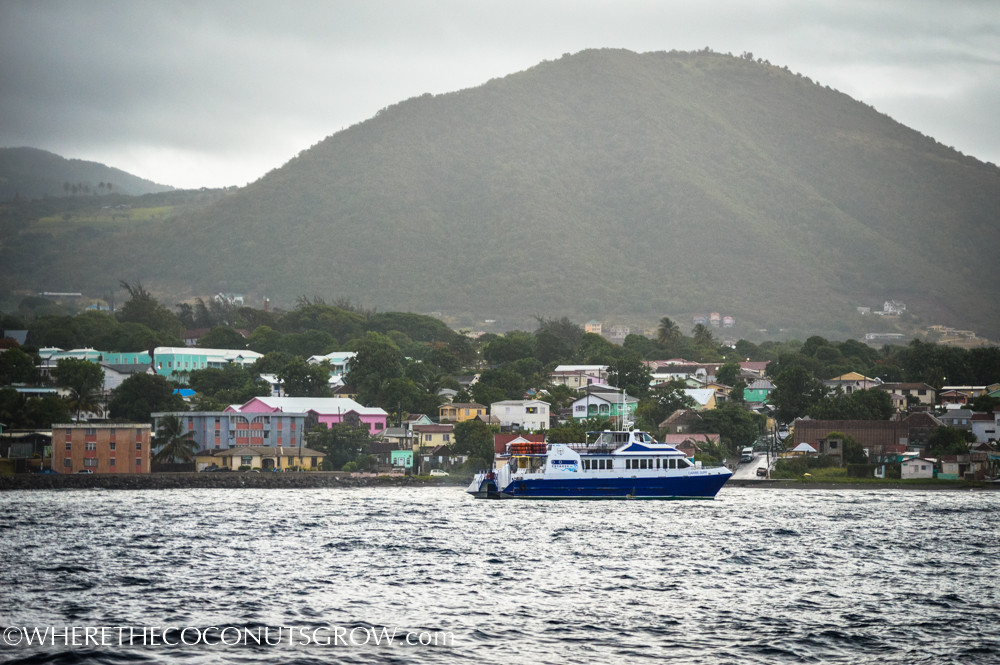
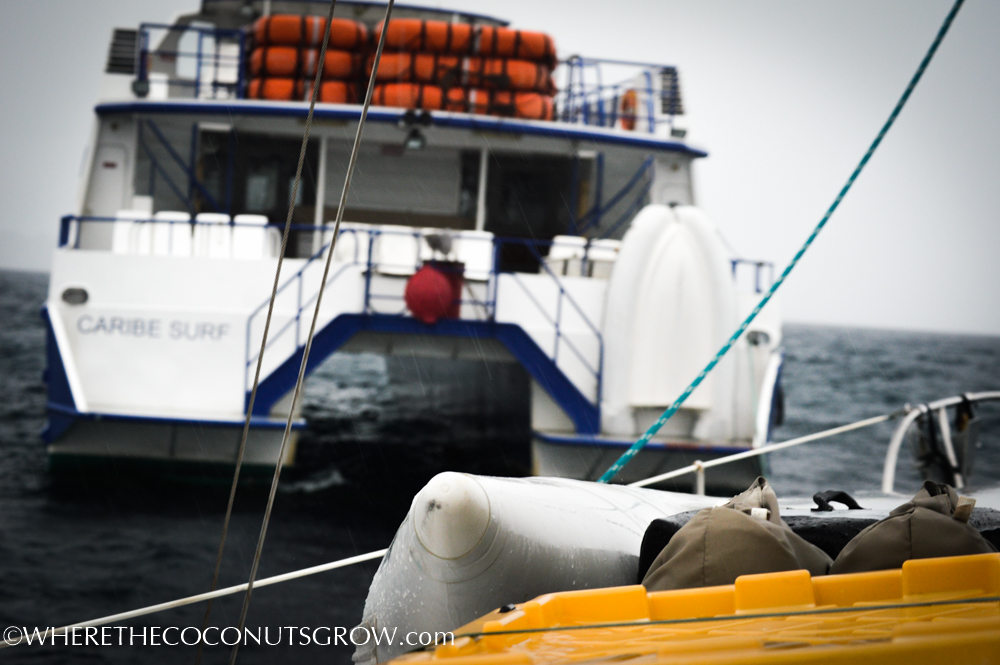
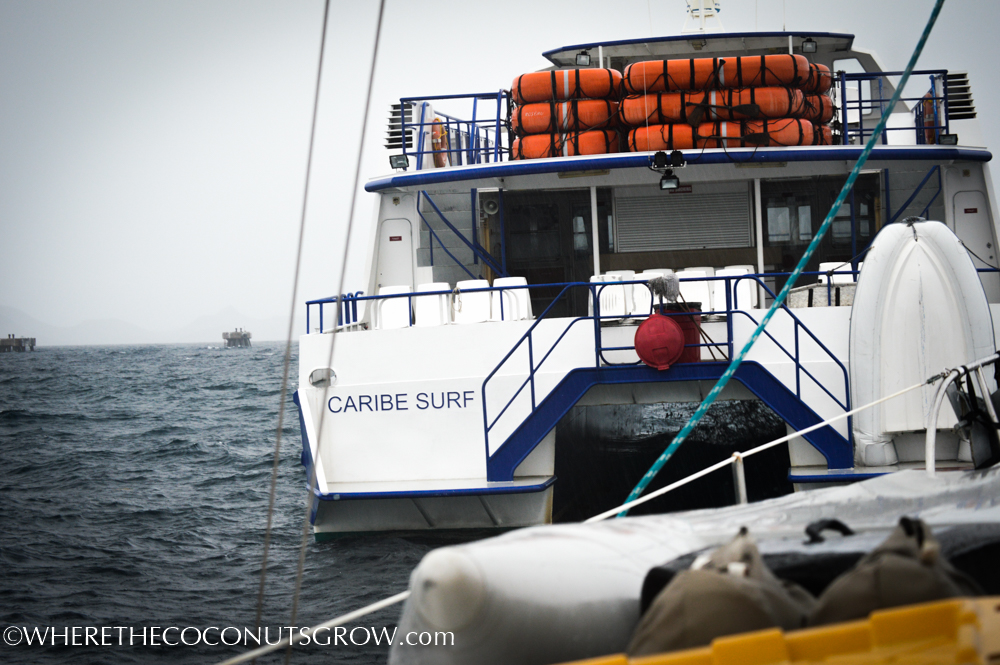
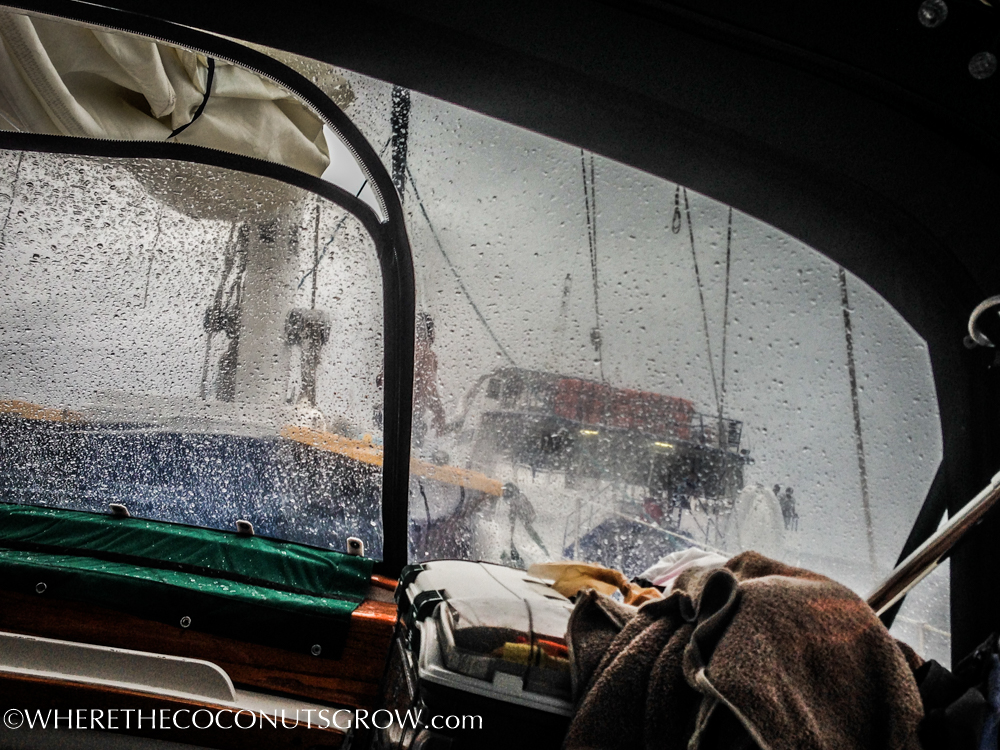
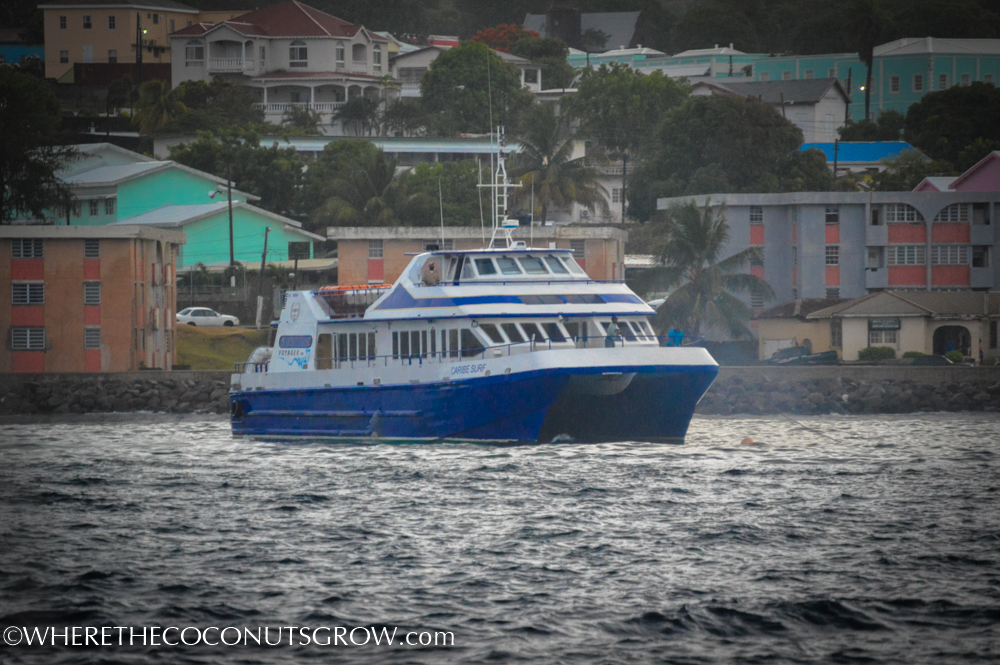
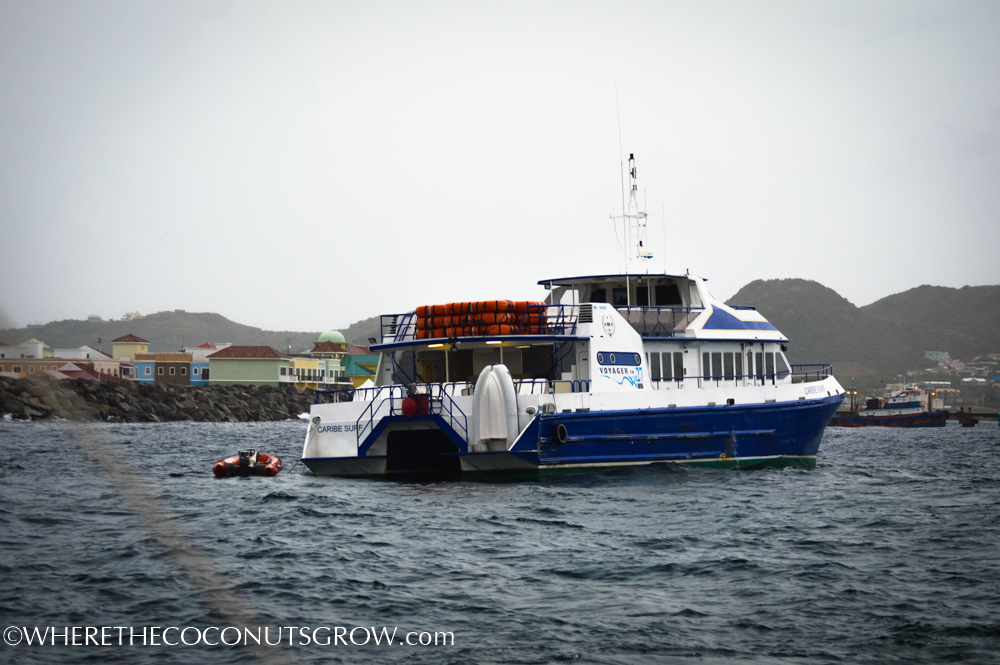
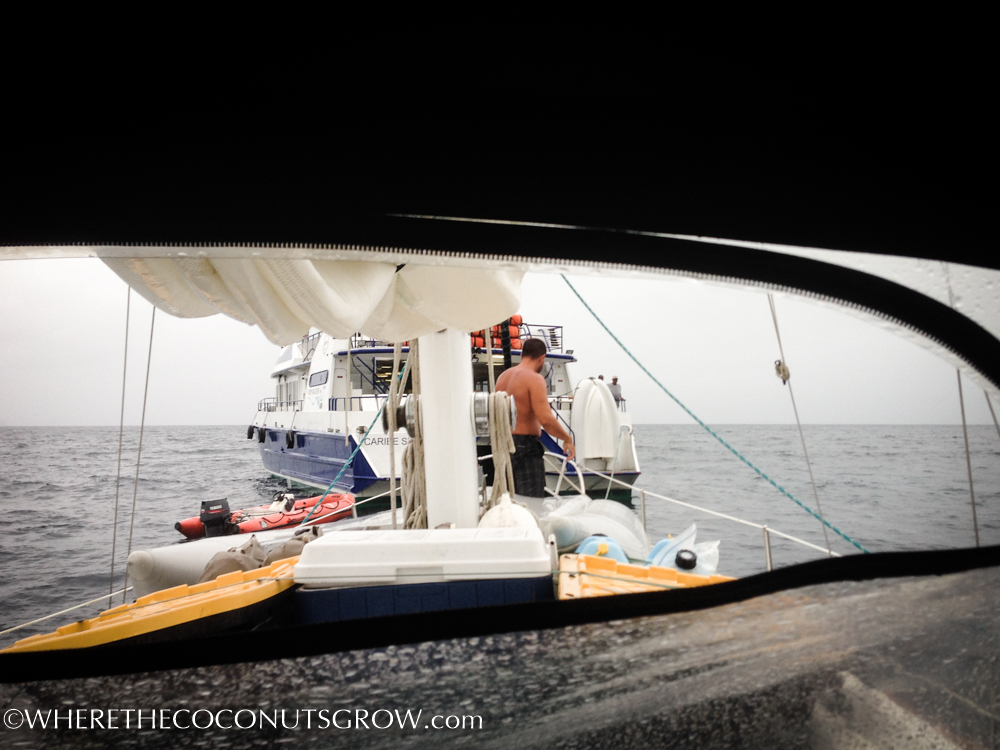
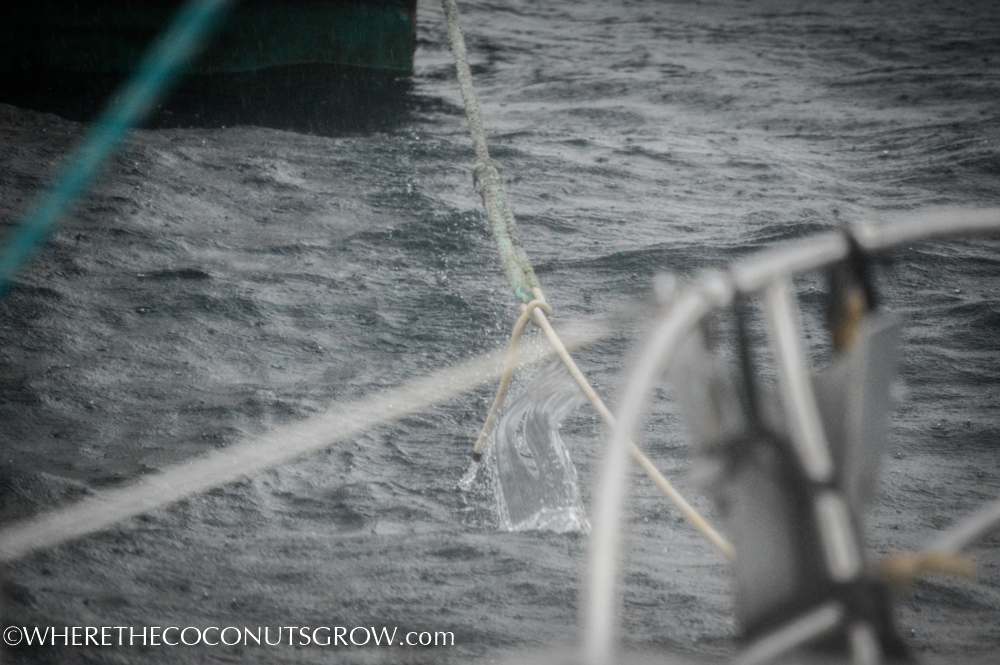
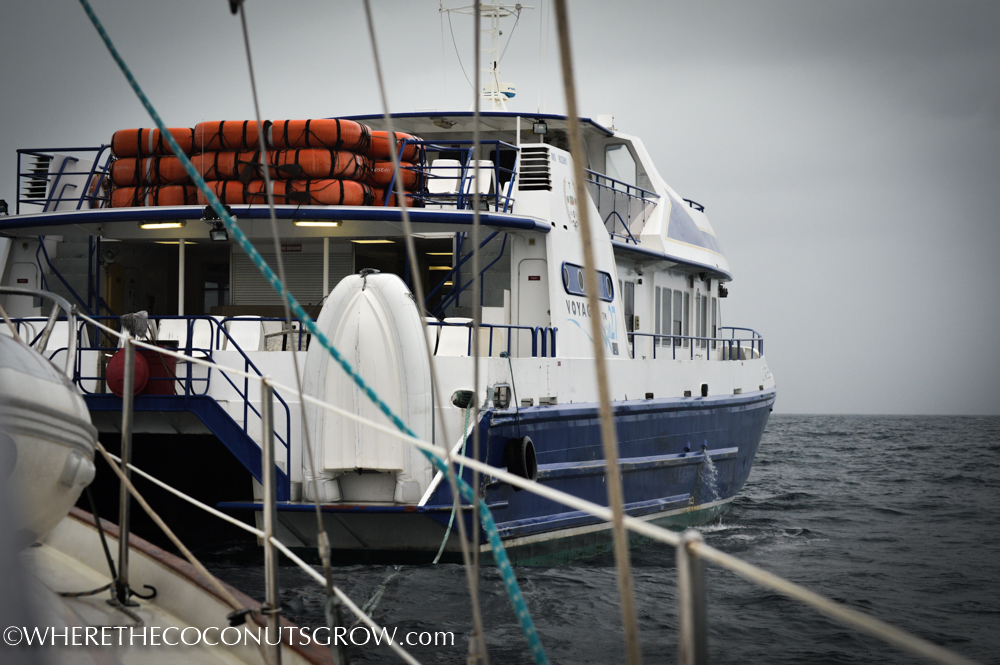
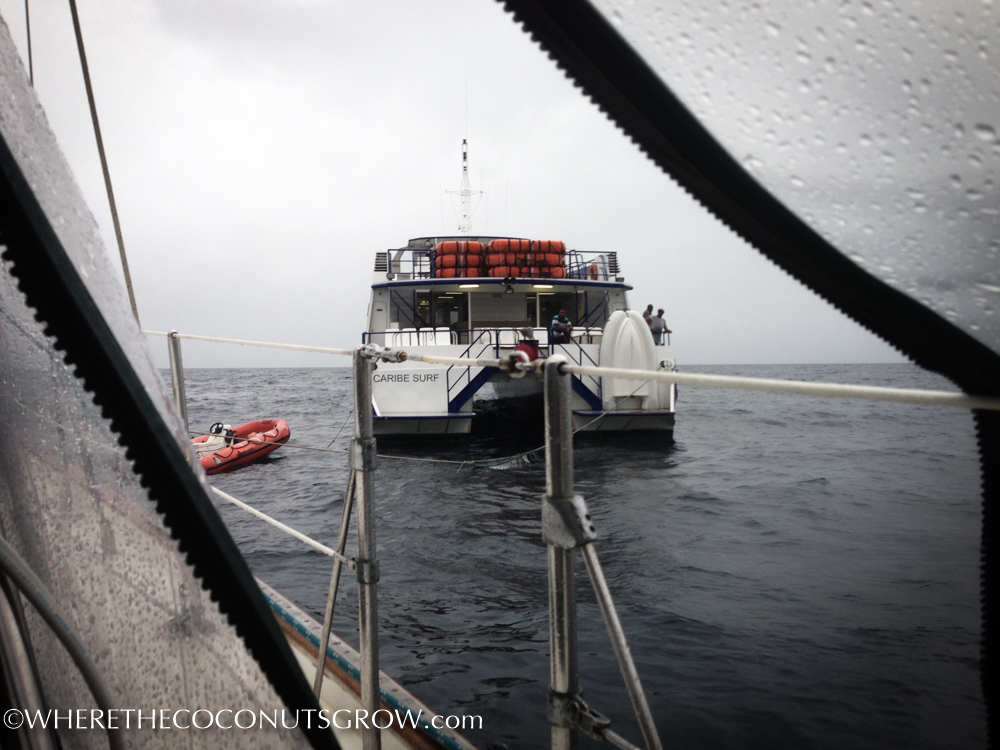
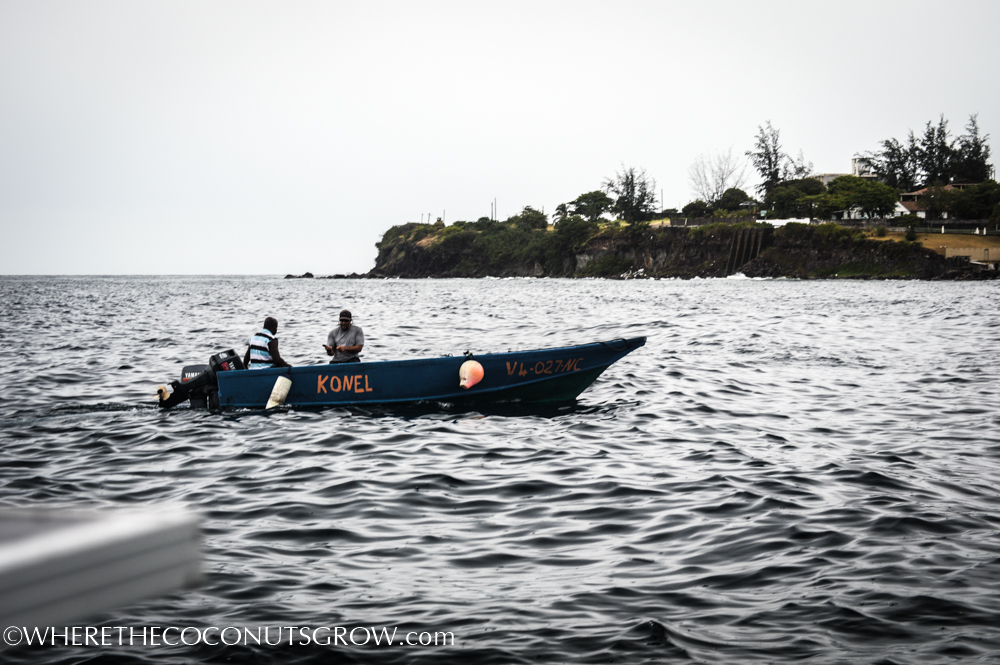
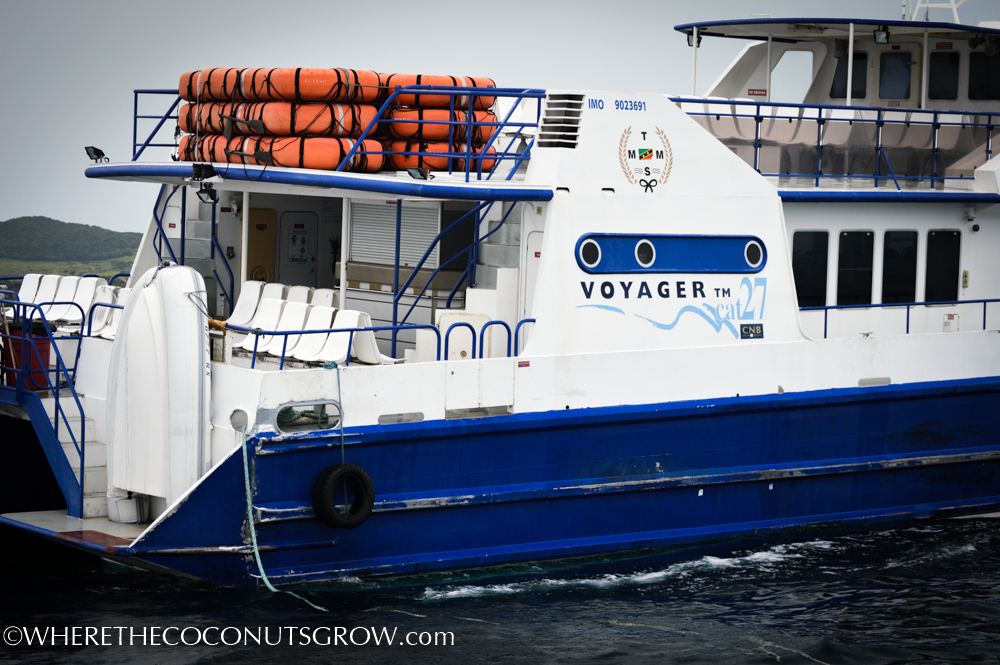
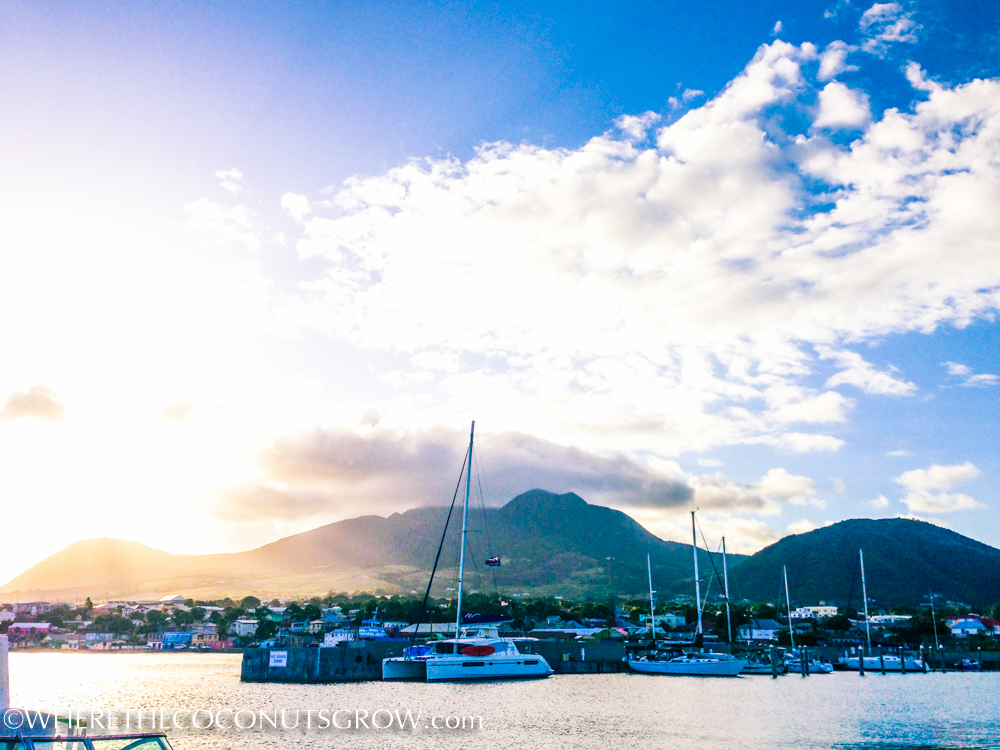
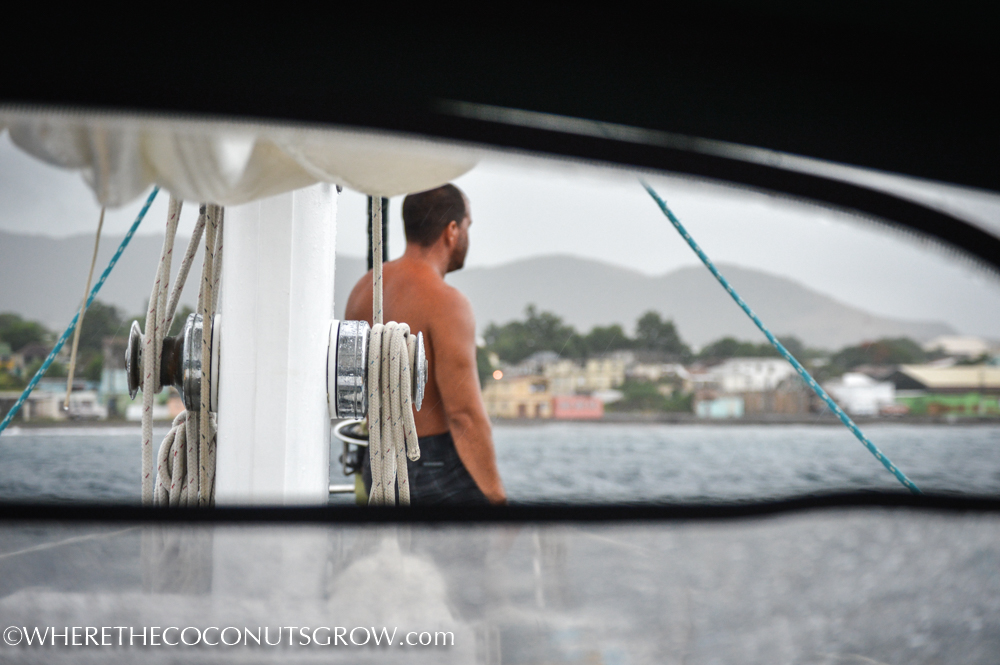
Whew! So glad everything worked out in the end … these are the kinda stories I hate to think about!
Thanks Cheryl! Definitely not fun stuff, but scary things happen at sea and it’s better to be aware of them than not. We were very lucky!
Yikes. Sounds terrifying. It’s one thing to be in a crowded anchorage with other similar sized boats dragging, but something totally different to have a ferry boat coming at you. Good thing it happened, or, rather, you were able to avoid it, during daylight hours.
Kristen, you’re right – it can be nerve wracking just with the fear of gusts in a crowded anchorage. We are very glad it was light enough to kind of see what was going on :)
Not a sailboat story, but when I was in the U.S. Navy in the late 60’s, I was on a destroyer and part of a flotilla on our way to Vietnam. We were a day out of Hawaii when a huge storm hit. There was a carrier, 6 destroyers and a cruiser as part of the flotilla. By the afternoon of the second day, the waves were breaking over the flight deck of the carrier and would completely cover the destroyers. Everyone was sustaining damage and the bilge pumps were having trouble keeping up with the water seeping through loose hull plates. Finally it let up and we continued on our way. A sailboat in those waves would have gone to the bottom.
Mikkel, WOW! I can’t even imagine what that must have been like. Thanks for sharing your story!!!
Well, once I accidently poked a hole in one of my water wings with my jet sky key. And then the big bannana boat came splashing by and making waves. My jet sky was 50 ft. away and I was bouncing around. It pretty was scarry. Did I mention I live in the desert where water adventures are somewhat limited.
That’s why I like hearing about your adventures so much. So keep posting and just keep sailing, sailing.
Happy trails,
SteveP
HAHAHA! Thanks for making us laugh Steve :) Glad you’re enjoying our adventures!!!
This is what makes a journey an adventure, and now you have just that much more experience. Biggest lesson, don’t fall asleep on an anchor watch. I remember an anchor watch in New Zealand, we were far more concerned about the other boats than ours drifting, and we tried to plot the locations of adjacent anchors as they were being set, just in case we had to power out as well. Great lessons learned, and good to know they retrieved your anchor. Keep on sharing we all get to learn.
Absolutely Capt! More experience is absolutely right. The next three squalls we had immediately after that one weren’t nearly as bad as they might have been without first having the ferry incident.
Harrowing! The two times we’ve let our anchor go we tied a fender to the line for easy retrieval. Of course, that’s not always an option in an emergency like you had.
My scariest moment of our Bahamas cruise also came at anchor. Our transmission to shaft coupling bolts had snapped and I only managed to get one of three back in. But we were in a secure anchorage with a benign forecast. Well at 3 am a vicious wind squall came through. Other boats near us with wind instruments clocked over 45 knots. We were tacking back and forth on our anchor violently, heeling over about 20 degrees. All the while I’m thinking we only have one bolt holding our prop shaft to the engine if we have to motor out of this. Suffice to say the Rocna anchor held fine. But it was an intense two hours while the wind was so strong. The worst seem to be when you are at anchor because you feel so helpless. At least underway, with sea room, you can reed and run with the squall. But we’ve learned to trust our Rocna.
Bill, that would have definitely been ideal.
Wow, tacking at anchor is not fun – we know what that feels like!! Rocna is an excellent anchor and would be our first choice if our Delta wasn’t working as well as it has for us. Great story – thanks for sharing!!!
WOW! A bit too much excitment. You both handled it well…….as you always do and always will…….this much I do know. And of-course as tense as this was you are always thinking……..to take a picture. Always thinking as you always do. Jody and Peter, you work well together. Hugs and more and so happy you came out on the sunny side of that storm. Love, Bean
Those pictures were all taken after the fact :) NO way did I have time to grab a camera in the first hours of that day. It was a bit easier when our adrenaline dropped. We’re glad to be on the sunny side now :)
You guys did everything necessary to save your boat … well done! The decision to ‘loose the anchor’ does not come easily but was certainly the correct option which of course you did because you are experienced sailors.
We had a situation as we entered Moorea Island on the east side at Vaiare … the wind was upward of 40 knots by the time we arrived in building seas …
Passed through the entrance to feel the wind forcefully kick in all the more … worked Impi up for a shallow anchorage in sand which according to the guide book was accessible on the landslide of the marks … ha ha … it certainly was not … but we were locked into a direction which had coral heads scattered about to the sides of us … and we could see them now shallowing ahead of us too …
Manoeuvring to the first marker in the ‘now howling wind conditions’ and a very stiff current out of the north east, demanded the engines to ‘punch some serious horsepower’, and of course Impi has a lot of ‘windage’ which in these winds was proving to be … interesting!
The depth meter was recording shallow depths as in my mind my eyes pictured the keels inches above coral heads … this did not feel right … and ahead of us and all around the markers, we observed scattered coral heads everywhere.
I held Impi steady which required working hard on the throttles … kinda put on the ‘pause button’ so Impi hovered in one place so Ana could take a better look at the situation … get a feeling for the true depth …
Ana, leaning out over the bow, gave me the sign … ‘I am not feeling confident’ … it seemed to us that in order to pass in enough depth of water, we were to pass these markers on the ‘sea side’ and NOT on the ‘land side’ as stated in the book.
So here we were … serious forces of nature pushing and pulling and a reef to either side with many coral heads in between … I had ‘relaxed the motors’ throttling on and off on the port side throttle to keep Impi into the wind … now again compensated by punching a bit of power on the starboard engine just to keep us stationary for a while whilst we took a breather to consider our options.
Ahead of us a charter catamaran (belonging to the hotel group, we think) lay tied to a mooring ball. They obviously move up and down along these markers clearing the coral heads … but then again ‘local knowledge’ helps … and furthermore, perhaps they carry less draft than do we …
‘No’ … our decision to proceed to calmer anchorage was a ‘No’.
We would rather drop anchor and ride out the conditions than take a risk where coral heads could punch a hole through our side!
No sooner than we had made the decision to back track a little to where we could drop anchor in clean sand with enough room to swing clear of coral heads, that all of a sudden the port engine decided to ‘die on us’.
To make matters worse, the weather was building and getting even stronger … I braved to peek at the wind-meter which was registering well over 40 knots … in fact we could hardly hear each other for the screeching and whistling sounds created by the wind in the rigging … the engine would not start and the starboard engine was of no use to me without the port side operational as it tended to push the nose around and down wind which would hasten our drift onto the reef, let alone all the coral heads we were now having to contend with.
We were in an emergency situation … I had no option but to accelerate the engine even if we were moving in the wrong direction. I knew that in order to have some form of control we needed sufficient enough speed to have water flow over the rudders so I could at least ‘steer the boat’ and get her nose facing upwind again.
This required some serious concentration as I had to ‘tap off’ now and again on the throttle … to allow Impi to drift between corals which were too shallow … kind of using the wind and current to ‘place the boat’ in strategic positions before punching the motor again for speed.
I quickly called out to Ana that she needed to lower the anchor just enough so it would dangle in the water … I have a button at the helm to do the rest of the anchor work if needed in an emergency or if we suddenly found ourselves in a ‘patch large enough between corals’.
Ana now could attend to other procedures.
Ana responded well and with the anchor now dangling for a quick descent if necessary, she immediately afterwards had run downstairs to engage the emergency house-bank battery switch which provided the voltage we needed to start the motor.
Thank goodness for this feature as now with sufficient battery power we were able to bring the motor back to life.
Had the engine not started, I now realise that we would have run out of space to manoeuvre and to be sure, I would most certainly have had to drop anchor and ‘hope for the best’ as that would put the boat at the mercy of the wind and current with the chance of swinging onto coral heads … at least until I could get a stern anchor fixed anyway, and this would not be easy in these conditions.
As we took control of the situation again I felt my heart pounding up in my throat … it was not a good situation to be in, but thanks to Ana’s prompt descent to the emergency start isolator switch and the fact that we kept ‘cool heads’ we managed to ‘save the day’.
In situations like this, it is fortunate that Ana and I work very well together and despite the seriousness of the situation, we make sure to be calm with each other and ‘work things out’.
We had manoeuvred Impi into a position nearby in shallow water but with enough room to swing freely at anchor.
Our only hope now, was that the anchor would find good sand and hold in winds that seemed to just keep strengthening.
I know I have said it many times before, but once again, I am ‘tickled pink with myself’ for having gone with the Rocna brand of anchor … it seriously bites and digs in quickly.
For a while we sat on board and contemplated all that had happened … Ana put the kettle on and brewed up a hot strong coffee … I sat there gazing at the anchor position I had placed on the plotter to make sure Impi was not dragging. Impi tugged hard at the chain but our position remained solid!
We have found ourselves in some serious situations … and of course we sailors always seem to come through it! I guess in the end one can never be too careful the old saying ‘hoping for the best but planning for the worst’ has saved many a boat and lives out here !
Holy Cow, Brent!! That is a great story!! I’m so glad everything turned out well for you. Great choice with the Rocna!! You’re absolutely right about hoping for the best and planning for the worst. It has saved us many times as well. We really appreciate you taking the time to tell your story!! It’s great for everyone to hear!
Holly Shit!! Two extremely terrifying incidents. I think all sailors have thought about getting off their anchor in a hurry. When fishing for halibut, I would take the end of the roe underneath then round back over the bow rail and attached a harmonious orange fisherman’s float to the bitter end. Being able to unclean the anchor pitch the float over the rail chase the fish and come back and retrieving anchor was needed several times for fish over 300 pound.
I couldn’t come close to touching the terror of some of these moments. The closest I can come was on delivery off Cape Mendocino in a gale with the wind blowing the tops off the waves that sounded like freight trains crashing (required earplugs in the cockpit). Waves would break over the Stern fill the cockpit with 50° water, making it a cold tub. As the storm abated the wind settled down, but the waves were still there. It was kind like a roller coaster ride and after the great big thrill hills were out of the way you had the small ones at the end, but it lasted about 18 hours.